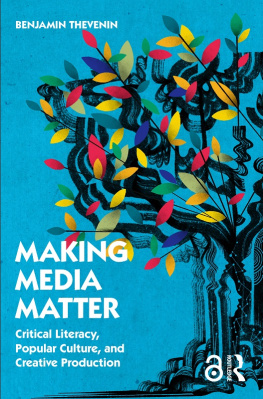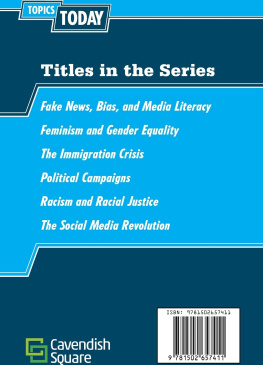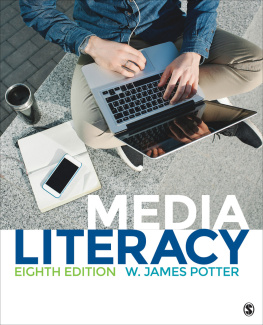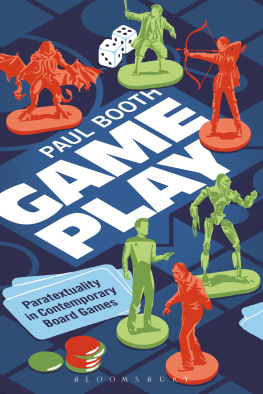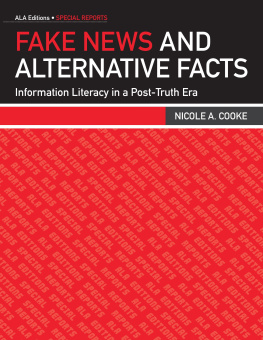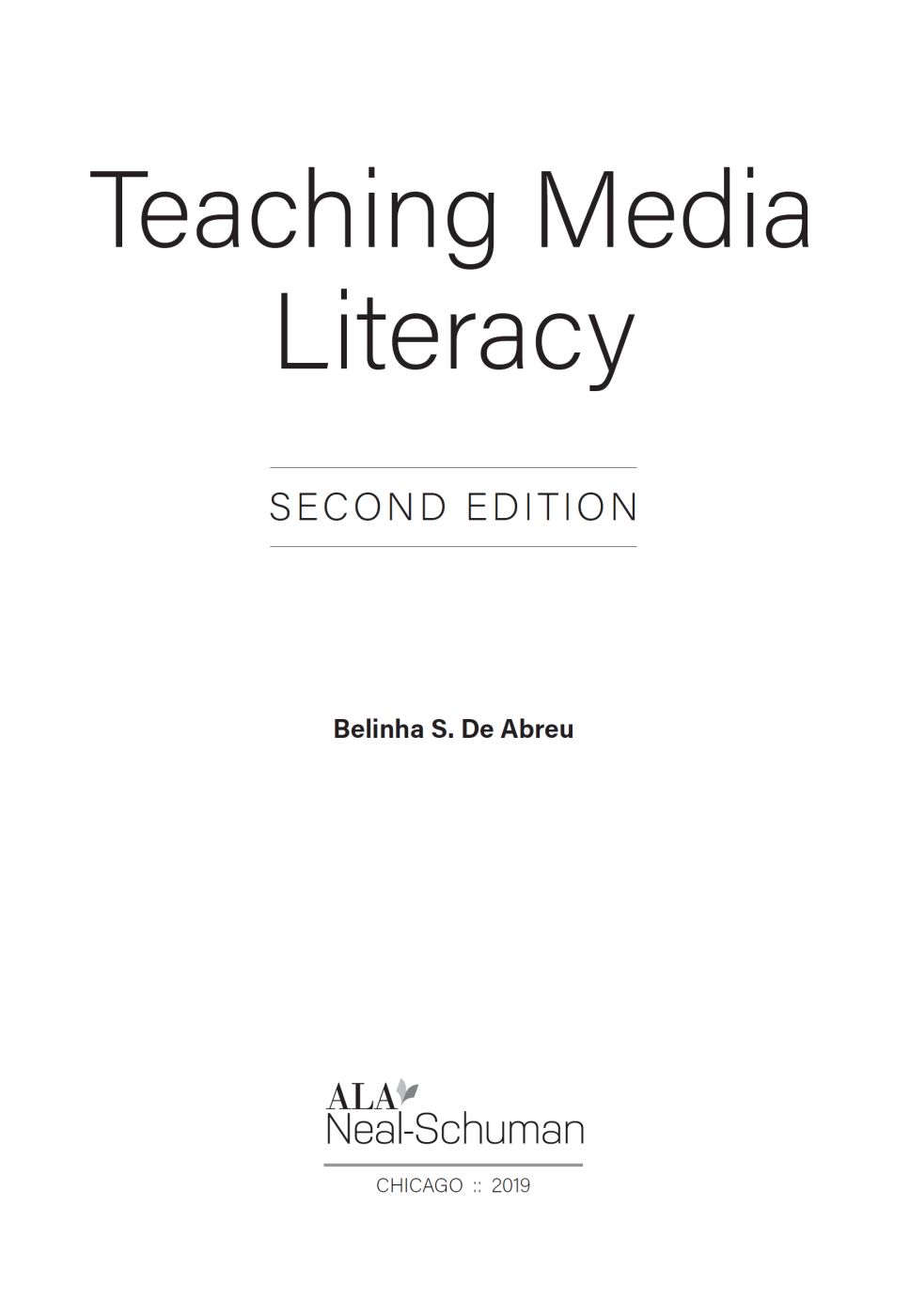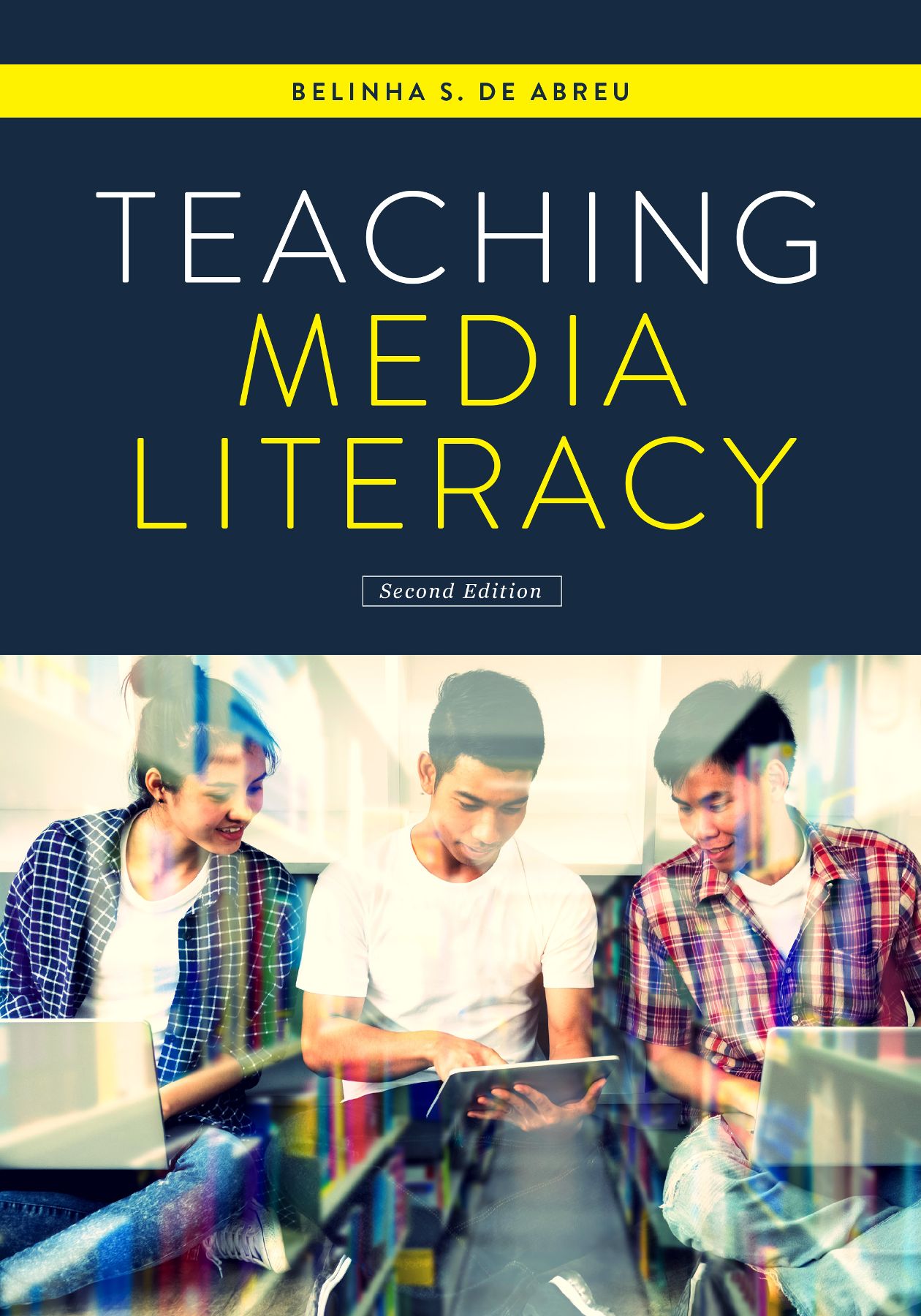
ALA Neal-Schuman purchases fund advocacy, awareness, and accreditation programs for library professionals worldwide.
2019 by Belinha S. De Abreu
Extensive effort has gone into ensuring the reliability of the information in this book; however, the publisher makes no warranty, express or implied, with respect to the material contained herein.
ISBNs
978-0-8389-1721-3 (paper)
978-0-8389-4611-4 (PDF)
978-0-8389-4612-1 (ePub)
978-0-8389-4613-8 (Kindle)
Library of Congress Cataloging-in-Publication Data
Names: De Abreu, Belinha S., author.
Title: Teaching media literacy / Belinha S. De Abreu.
Description: Second edition. | Chicago : ALA Neal-Schuman, an imprint of the American Library Association, 2019. | Includes bibliographical references and index.
Identifiers: LCCN 2018049834 | ISBN 9780838917213 (print : alk. paper) | ISBN 9780838946114 (pdf) | ISBN 9780838946121 (epub) | ISBN 9780838946138 (kindle)
Subjects: LCSH: Media literacyStudy and teaching.
Classification: LCC P96.M4 D4 2019 | DDC 302.23071dc23
LC record available at https://lccn.loc.gov/2018049834
Cover design by Kim Thornton. Imagery Adobe Stock.
For my parents, my greatest teachers, who helped me begin and sustain my journey...
Francelina de Abreu
and
Jos Jesus de Abreu
19322014
and for
Barry Duncan
19362012
My first teacher of media literacy education.
CONTENTS
by Pam Goble, Ryan Goble, Ben Peterselli, and George Wedel
by Marcus Leaning
by Joanna Marshall
by Kathleen Currie Smith
by Marialice B.F.X. Curran and Curran Dee
by Emily Soler
by Ryan Goble, James Hultgren, Michael Roethler, and Nessa Slowinski
by Jimmeka Anderson
by Neil Andersen
by Michael Godbout
PART II. The Major Formats of Media
Ready-to-Teach Lessons
Media literacy changes the way I look at everything, not just TV, computer, iPod; it changes the way my eyes work. It teaches me how to learn.
G. Shapiro, high school student, Ithaca, NY, 2012
I incorporate this student quote in all my presentations because I believe it encapsulates the power and significance of media literacy education. Media literacy education has the power to change the way that students see the world. As the executive director of the National Association for Media Literacy Education, I believe that media literacy is the most important skill of the twenty-first century. Media literacy is the ability to access, analyze, evaluate, create, and act using all forms of mass communication. The purpose of media literacy education is to help individuals of all ages develop the habits of inquiry and the skills of expression that they need to be critical thinkers, effective communicators, and active citizens in todays world.
The media have a profound impact on all of us. It doesnt matter what you are passionate aboutit can be social justice, health care, climate change, gun control, or immigrationyou are influenced by the messages you are receiving and creating. It doesnt matter where you are from or which side of the political spectrum your beliefs fall on. The media ecosystem is a part of your world and you need to understand it.
If we are serious about helping our youth be successful in this world, media literacy is critical. It is not only necessary; it has to be a national priority. Media literacy education should be an essential part of our education system. Media literacy skills are vital to becoming an active and engaged citizen. To be literate in the twenty-first century, one must be media-literate.
In the Stanford Education Groups 2016 study Evaluating Information: The Cornerstone of Civic Online Reasoning, researchers determined that students have trouble judging the credibility of the information they encounter online. The study concluded that overall, young peoples ability to reason about the information on the Internet can be summed up in one word: bleak.
I was not shocked by the findings of the study. How would students know how to judge the credibility of information online if we are not fully committed to media literacy education in the United States? How can we be surprised, given the fact that the information landscape has changed drastically over the past five years, and our education system has not been able to keep up? How can we expect students to know how to navigate this complicated ecosystem when we dont teach them the skills they need to do so?
Our information landscape has changed exponentially in the last decade, and the pace of change is not going to slow down. The urgency for media literacy education has never been greater. We must teach students the skills they need to navigate this complex world. We must help them find their voice and the answers to important questions.
- What does it mean to be well-informed today?
- What does it mean to be a citizen today?
- What does it mean to be engaged in this participatory culture?
- What are the skills we need to be literate in todays world?
These are questions we must grapple with. We must be willing to search for answers with our students, and let those answers evolve over time as technological changes create different forms of communication and different paths of information flow. Media literacy education empowers individuals and helps them develop a habit of informed skepticism that will be valid today and in the future, no matter what that future may bring.
If you have picked up this book, you have already decided that media literacy education is important. I applaud you and urge you to bring the lessons in these pages to your classroom. Your students will be better for it, and so will the world they live in.
Michelle Ciulla Lipkin
Executive Director, National Association for Media Literacy Education
2019
M edia literacy is starting to attract attention. State standards and education courses now address its importance. Educators discuss it at national conferences and summer institutes. New classroom resources support the integration of media literacy into the curriculum. These developments are all good news for those teachers who are already eager to accommodate their students interest in popular culture. Other teachers, however, may have reservations about bringing controversial topics into the classroom, or they may feel unprepared without an organized curriculum.
Teaching Media Literacy combats those reservations with its combination of theory and practice. Teachers, especially those reluctant to teach media literacy, need a practical guide like this one. Belinha De Abreus lesson plans address both analysis and production, providing the building blocks of an authentic media education.
Teaching Media Literacy also helps educators pinpoint important teachable moments, from coverage of the 9/11 attacks and Hurricane Katrina to the Academy Awards or a new video game. Each lesson includes objectives, materials, assessments, and reflection. De Abreu provides challenging key questions and multimedia tie-ins that can be used to launch follow-up activities. In teachers will find the best websites, films, and media education organizations, all of which can help make lessons more vibrant and relevant.
De Abreus in-depth explorations of cultural contexts and media conventions make media studies more meaningful. I feel sure that the clear path through the media environment outlined in this book will inspire other educators in their own media literacy journeys.
Next page



